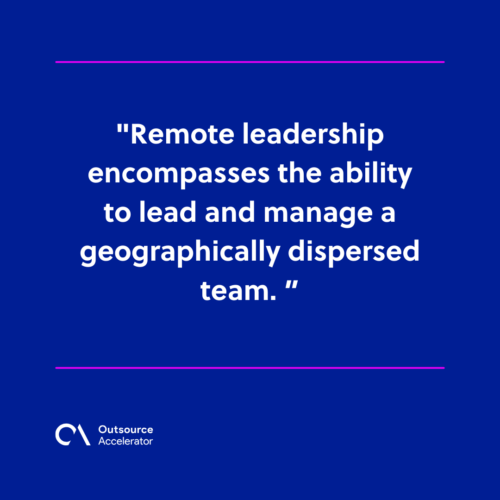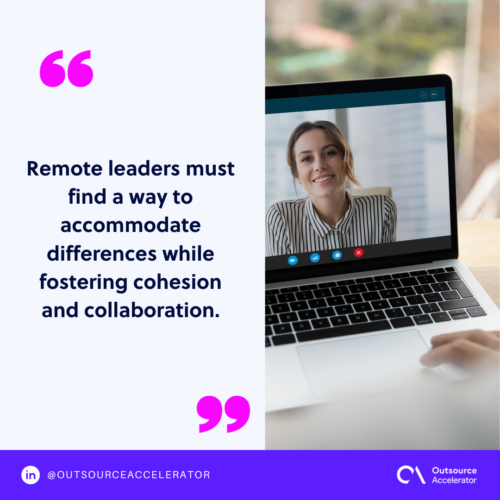The impact of remote leadership

With the increasing prevalence of distributed teams, leaders must navigate the unique challenges and opportunities of leading from a distance.
Managing a remote team has distinct differences from managing teams in person. Practicing remote leadership is the key to maintaining performance among distributed teams while increasing their morale in the virtual workplace.
If you handle a team of remote employees like those supplied by Remote Employee, this article may be especially beneficial to you.
In this article, let’s explore the concept of remote leadership and its impact on modern businesses.
What is remote leadership?
Remote leadership encompasses the ability to lead and manage a geographically dispersed team. It involves overseeing and guiding individuals who work remotely, often from different locations.
Remote leaders must adapt their leadership style to foster communication, collaboration, and productivity in a virtual setting.

Qualities of remote leadership
Remote leaders must possess the following skills to maintain effective team leadership:
- Exceptional communication skills. Effective remote leadership involves strong communication skills that enable them to bridge the physical gap between team members.
- Digital fluency. Remote leaders should leverage digital tools and platforms for seamless collaboration and information sharing.
- Trust-building. Building trust is crucial in remote leadership. Trust is the foundation that enables effective collaboration and productivity.
- Empathy. Remote leadership also comes with compassion and empathy with their team members, considering their unique challenges and needs.
- Results-oriented mindset. Remote leadership involves focusing on outcomes and deliverables rather than micromanaging activities.
- Inclusive leadership. Effective remote leaders value diversity and create an inclusive work environment.
Challenges of remote leadership
Leading a remote team comes with its own set of unique challenges:
Collaboration issues. One of the major hurdles is balancing the needs and preferences of individual team members, especially when they have different work styles. Remote leaders must find a way to accommodate differences while fostering cohesion and collaboration.
Inconsistent work cultures. Remote workers may be secluded from the broader company culture and values. This results in a disinclination to understand and incorporate them.
Striking work-life balance. With remote work, the boundaries between work and personal life become more blurred, which can cause work-life imbalance and burnout amongst remote team members.
Unequal access to resources. Remote workers may not have equal access to resources such as equipment, software, and hardware, which hinders productivity and creativity.

Strategies to achieve success in remote leadership
To succeed in remote leadership, it is important to implement effective methodologies tailored to the remote work environment.
Let’s explore the strategies to elevate your remote leadership skills and create a thriving virtual team.
Elevate communication strategies
Communication lies at the heart of remote leadership.
Invest in robust communication tools that enable seamless and efficient communication among team members. Emphasize the value of regular check-ins, video conferences, and virtual team meetings.
Encourage open and transparent communication to foster a sense of connection and collaboration.
Vary approach to measuring productivity
Traditional productivity metrics may not always apply in a remote setting. Instead, consider focusing on outcomes and deliverables as indicators of productivity.
Allow flexibility in work schedules while ensuring alignment with team goals. Establish clear expectations and provide autonomy to remote team members, empowering them to manage their time and tasks effectively.
Offer mentorship and support
Remote leadership prioritizes mentorship and professional development opportunities for their team members.
Create a framework where individuals can seek guidance, receive feedback, and continuously grow in their roles. Encourage knowledge sharing and virtual coaching sessions to facilitate skill development and career progression.
At the same time, remote leaders can undergo training programs and seminars.
Respect each member’s workflow
Remote work is not one size fits all. Recognize that each team member may have different working styles and preferences.
Explore flexible work arrangements that accommodate various work styles, allowing team members to optimize their productivity.
Celebrate diversity within your team and utilize it as a strength, leveraging each individual’s varied perspectives and strengths.
Build a culture of trust
Trust is the foundation of remote leadership. Building trust goes beyond just words. It requires consistent actions and follow-through on commitments.
Foster a culture of trust by setting clear expectations, honoring commitments, and demonstrating trustworthiness as a leader.
Trust empowers team members to take ownership and feel motivated to contribute their best.
Exercising remote leadership: Embracing the possibilities
Remote leadership fosters meaningful connections and drives collective success in a virtual world.
Exercising remote leadership requires consistent effort and adaptability. Embrace technology and stay updated on emerging tools and platforms that facilitate remote collaboration.
Invest in building strong relationships with your remote team through regular communication, virtual team-building activities, and celebrating achievements. With a sense of community and camaraderie, you foster a team culture that thrives in the virtual realm.

Remote leadership presents both unique opportunities and challenges. You can unlock the full potential of remote work by:
- Understanding the dynamics of leading a remote team
- Developing essential qualities
- Implementing effective strategies
Embrace the impact of remote leadership and harness the possibilities it brings for success in today’s ever-evolving work landscape.







 Independent
Independent




